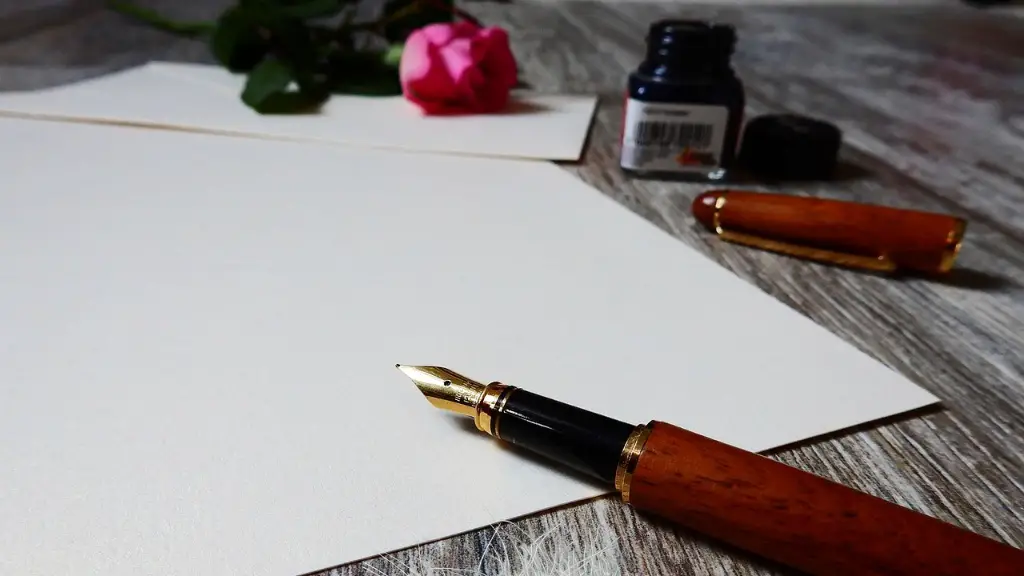Medieval poetry is a literary art form that dates back to the Middle Ages, a period of history between the 5th and 15th centuries. It is generally made up of short verses written in a specific form and often includes elaborate rhyme schemes and complex metres. These poems may be used to recount stories, express feelings or ideas, or to simply entertain listeners.
Medieval poetry was typically composed in a variety of languages, including Latin, Old French, and Old English. Many of the poets of this period are not known, as much of their work has been lost or destroyed over time. Scholars have been able to identify some notable medieval poets in both literature and manuscript sources, with Geoffrey Chaucer and Alfred the Great being two of the most famous.
There are several common types of medieval poetry, including allegorical or satirical works, lyrics, and epics. Allegorical or satirical works were often used to convey symbolic messages or to criticize aspects of the culture or court. Lyrics are often found within songs and provide depth to the storytelling. Epic poems, such as “Beowulf” and “Sir Gawain and the Green Knight”, were used to tell heroic tales of martial prowess and adventure.
Historians and scholars agree that the influence of medieval poetry can still be felt today. Its influence can be seen in the structure of modern day sonnets, hymns, and other poetic devices. Works of medieval poetry have also inspired literary movements and styles throughout the centuries, such as Romanticism, Epic literature, and Surrealism.
Themes commonly explored in medieval poetry include religion, war, and the complexity of a fallen world. Religion was often treated as the only possible solution to the human condition and the source of salvation, or as a leisure activity to show devotion and piety. War was both a popular and poetic theme, leading authors to create lengthy epics to glorify combat and bravery. Meanwhile, the idea of a fallen and broken world was often explored to provide insights into the conflict between good and evil.
Despite its age, medieval poetry is still appreciated by modern scholars and readers. Its impact is seen in the immense popularity of early English literature and the art of poetry. It has influenced the development of the English language, providing a strong foundation for both classical and contemporary styles.
How was Medieval Poetry Written?
The writing of medieval poetry followed a specific structure, conforming to the conventions of the time. This structure was based on an intricate combination of poetic forms, rhyme schemes, syllabic patterns, and meter. Each poem was written in a unique blend of these features, depending on the author’s distinct style and the chosen theme.
The most common form for medieval poetry was the sonnet, which usually consisted of 14 lines written in a connected prose. A sonnet would often include several quatrains, or four-line stanzas, with a rhyme scheme that could be repeated. Other forms included ballads, madrigals, and pastoral poems.
Poets made use of a range of tools to create their works, such as alliteration, metaphors, and similes. These methods were used to create vivid images that would engage the mind of the reader and evoke an emotional response. Poets often experimented with unusual word order and structure, often breaking the traditional prosaic form and introducing more creative appearances.
Religious and Cultural Influences on Medieval Poetry
Religion was a major cultural influence on medieval poetry, as many writers sought to incorporate religious themes into their works. Religious beliefs were a common thread in many pieces, providing authors with the opportunity to express their opinions and provide teachings that could be applicable to many different situations.
Cultural conventions also had an impact on medieval poetry. These conventions could include the use of chivalry, honor, and courtesy in works, as well as the reverence of monarchs and aristocracy. These themes provided a sense of security and stability to the audience, and often served as a blueprint for proper social behavior.
Medieval poetry was also used to explore notions of personal identity and power dynamics between individuals and society. It was often used to discuss issues such as gender, rank, and class. In fact, the works of some women writers such as Christine de Pizan and Marie de France demonstrate the importance of their voices in this regard.
Legacy of Medieval Poetry
Medieval poetry has had a lasting legacy on modern art, literature, and culture. It has made its mark on popular styles of writing, with original pieces helping to shape current trends. Many classic works of modern literature, including William Shakespeare’s plays, have been heavily influenced by medieval poetry.
In addition to its influence on literature, medieval poetry has also had an impact on the performing arts. Various forms of music and dance were often used to interpret and illustrate the works of medieval poets, bringing them to life. It is this very tradition that has been carried on to the modern day, with art forms such as ballet and opera remaining deeply indebted to medieval style.
As a result, the themes and ideas of medieval poets are still being discussed and developed today. From themes of love and loss to moral teachings and religious lessons, medieval poetry serves as an important point of reference when exploring modern works of art.
Effects of the Printing Press on Medieval Poetry
Prior to the invention of the printing press, manuscript copies of medieval poetry needed to be made by hand. This process was both time consuming and costly, and often left the quality of the literary piece open to interpretation. With the invention of the printing press, however, authors no longer had to rely on the accuracy of expensive manuscripts. Instead, they could have their texts printed lower cost and in larger numbers than ever before.
The printing press also made medieval works more widely available, allowing authors to reach a larger audience. This opened up the possibility of criticism, with readers having the opportunity to provide feedback and inspiring authors to develop their works in new and exciting ways.
The invention of the printing press also made it easier for authors to communicate with one another, creating networks of writers and cultivating a sense of community. By exchanging ideas and information with like-minded poets, authors were able to refine their approach and readily refine their art.
Advancements in Technology and New Poetic Forms
The introduction of new technologies has had a profound effect on the literary world, with writers being able to create works of art at an unprecedented scale. By leveraging platforms such as the internet, poets can now participate in global conversations and craft pieces that span the entire world.
Technology has also allowed poets to create works in entirely new forms, with formats such as slam poetry and spoken word poetry growing in popularity. These new forms allow writers to engage with their audience in a more intimate and immediate fashion, conveying messages in a more engaging and interactive way.
In addition to these new kinds of works, technology has also made it easier for authors to share their work with a wider audience. Whether through social media, self-publishing, or even publishing platforms, poets now have far more options for having their work read and appreciated by a larger audience.
The Impact of Social Media on Medieval Poetry
Social media platforms such as Twitter, Facebook, and Instagram have paved the way for poets to reach out to readers and garner a larger following of fans. Through the use of hashtags and other forms of curation, poets are able to quickly spread the word about their work and get valuable feedback on their pieces.
Social media has also enabled forgotten poets and works to be discovered, with platforms such as Twitter allowing readers to explore literary pieces that were never widely circulated in the past. This has opened up the possibilities for readers to engage with medieval texts, enabling them to connect with literature from centuries ago and gain a deeper understanding of pre-modern works.
The rise of social media has further allowed poets to engage in international conversations and address pressing topics from an intercultural perspective. By leveraging the immense reach of the internet, poets now have the potential to make a real impact on the world and shape the global narrative.

